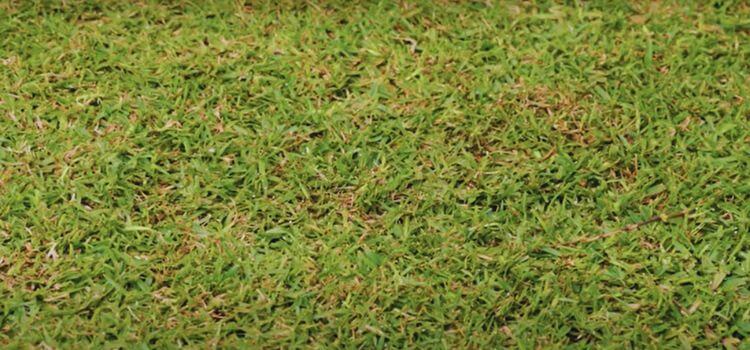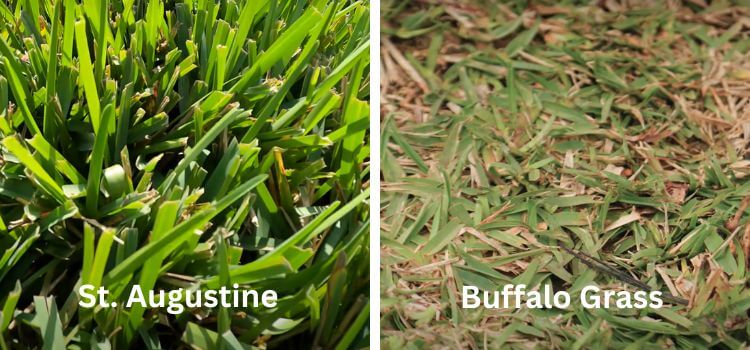As an Amazon Associate, I earn from qualifying purchases.
Selecting between Buffalo Grass and St. Augustine Grass depends on your lifestyle, environment, and maintenance needs.
When picking the perfect grass for your lawn, the options may appear as vast as the sprawling greens themselves.
Their lush, verdant appearance and rich, bright turf are well-known. Each grass variety requires different maintenance and is suited to its environment.
In this comparison, we delve into the details about buffalo grass vs. St. Augustine that will help you make an informed decision.
Buffalo Grass
Buffalo Grass, often touted as a “Native North American” turf, has been a staple grass for centuries in many plains and prairie states. As a warm-season grass, it succeeds in dry climates with mild winters.
Augustine Grass
St. Augustine Grass is a transplant from the West Indies, claiming a warm welcome in the United States, especially in the Gulf Coast and other Southern regions. It’s beloved for its wide blades and dense coverage, making it a favourite for many southern lawns.
Buffalo Grass vs. St. Augustine: A Complete Comparison
There is a Comparison table below. This Table provides a basic overview of buffalo grass and St. Augustine before delving into each variation.
Buffalo Grass | St. Augustine Grass |
The native american turf. | The caribbean import grass. |
Its mowed height can range from 2 to 3 inches. | Taller mowing heights, generally in the 3 to 4-inch range |
The desert darling. | The warm-wetter wonder. |
Low maintenance, high satisfaction. | The soil sensitive. |
The tough as hoof choice. | Lush, but fragile underfoot. |
Sipper of the lawn world. | The thirstier companion. |
The native and affordable. | The caribbean investment. |
Here is a detailed discussion about Buffalo Grass vs. St. Augustine:
Appearance and Aesthetic Appeal
How do buffalo grass and St. Augustine differ visually? This section explores their appearance, colour, and texture to help you picture each variety in your yard.
Buffalo Grass
Buffalo Grass can be silky due to its delicate, curled leaves and short, thick growth. Its mowed height can range from 2 to 3 inches, a choice that echoes its natural prairie setting.
Augustine Grass
St. Augustine boasts wide, flat blades with a rich blue-green hue that beckons memories of a sleek, coastal lawn. Taller mowing heights, generally in the 3 to 4-inch range, maintain the balance of its broader leaf stance.

Climate and Adaptability
Each grass has a sweet spot when it comes to climate and soil conditions. Here, we dive into which grass type thrives in various regions.
Buffalo Grass
Buffalo Grass survives high temperatures in the American West’s hot and dry regions. It can tolerate extreme temperatures, from sizzling summers to frosty winters.
Augustine Grass
St. Augustine is the choice for areas with warm, humid environments, such as southern states and coastal regions. It revels in consistent moisture but can shudder in the face of harsh winters.
Maintenance and Care
Lawn care can be a labour of love or a quick task, depending on the grass you select. Detailing the care requirements of each grass type provides crucial insight.
Buffalo Grass
Buffalo Grass requires sun and periodic mowing to preserve its appearance. It’s not fussy about soil types and is drought-resistant once established.
Augustine Grass
St. Augustine’s care demands are higher, with a strong preference for well-drained soils. Regular watering is necessary, and keeping the right balance can be critical to its health.
Durability and Strength
How well does each grass hold up under pressure? This section assesses their strength against foot traffic and environmental challenges.
Buffalo Grass
Buffalo Grass can bear the brunt of light to moderate foot traffic without needing much recovery time. It’s resilient against common lawn diseases and can handle medium shade.

Augustine Grass
St. Augustine’s thick growth offers some strength, but it’s not as durable as Buffalo Grass. It’s sensitive to foot traffic, and overuse can lead to thinning areas that need careful renewal.
Lack of Tolerance and Water Requirements
Understanding how each grass variety deals with lack and its ensuing water needs is a fundamental concern for water protection and landscape health.
Buffalo Grass
Buffalo Grass is famous for its low water needs and ability to maintain colour and coverage with minimal irrigation. It is an attractive choice for regions prone to lack and water restrictions.
Augustine Grass
St. Augustine Grass needs constant and more significant amounts of water to succeed, especially in hot, dry climates. This water dependency may not be suitable for all environments or water use rules.
Pest and Disease Resistance
A lawn plagued by pests or diseases is no one’s dream. Discover how well each grass type fends off common threats.
Buffalo Grass
Buffalo Grass has developed powerful resistance to many pests and diseases. Given its long history in the American prairies, it is a low-maintenance choice for those who prefer a chemical-free lawn.
Augustine Grass
In comparison, St. Augustine can be more sensitive to certain pests and disorders, such as chinchbugs. While not inevitable, it does require attention and sometimes intervention to maintain a healthy lawn.
Cost and Availability
The big question for many homeowners: how much will it cost to install and maintain each grass type, and how readily available are they?
Buffalo Grass
As a native grass species, Buffalo Grass seed and sod are often more accessible and cost-effective. Reduced water and maintenance needs over time, contributing to long-term savings.
Augustine Grass
Imported from the Caribbean, St. Augustine Grass may initially cost more to install due to the expense of seed and sod. Additionally, its higher maintenance requirements can lead to increased costs over the years.
FAQ: Buffalo Grass vs. St. Augustine
Buffalo Grass is a warm-season grass known for its lack of patience and low maintenance requirements. Buffalo is more drought-resistant than St. Augustine grass, which is more adaptable to different climates.
For high-traffic areas, St. Augustine may be more suitable due to its rapid growth and repair capabilities. It’s essential to ensure proper maintenance and watering to facilitate recovery.
Buffalo Grass prefers full sunlight and can struggle in shaded areas. If you have shady spots, consider choosing St. Augustine or another shade-tolerant grass species.
It depends on your specific climate and soil conditions. Local nurseries or landscaping services often provide expert recommendations for the best grass type for your area.
St. Augustine grass should be mowed to a size of about 2.5 to 4 inches, depending on your preference and soil type.
It’s generally not recommended to mix grass types as they may compete for resources and have differing care needs. It’s best to stick with one type for a more uniform lawn.
Conclusion: Buffalo Grass vs. St. Augustine
Deciding between Buffalo Grass and St. Augustine is not simply a matter of choosing the “better” grass. The appropriate balance between grasses’ attractiveness, environmental suitability, and lawn maintenance is vital.
Understanding the benefits and needs of each grass variety will help you grow the ideal lawn.In your journey to greening your space, consider consulting with local horticulturists or landscapers for personalized guidance.
Ultimately, the grass you choose will grow into the perfect canvas for your outdoor oasis, so choose wisely and enjoy the splendour of nature in your backyard.

